








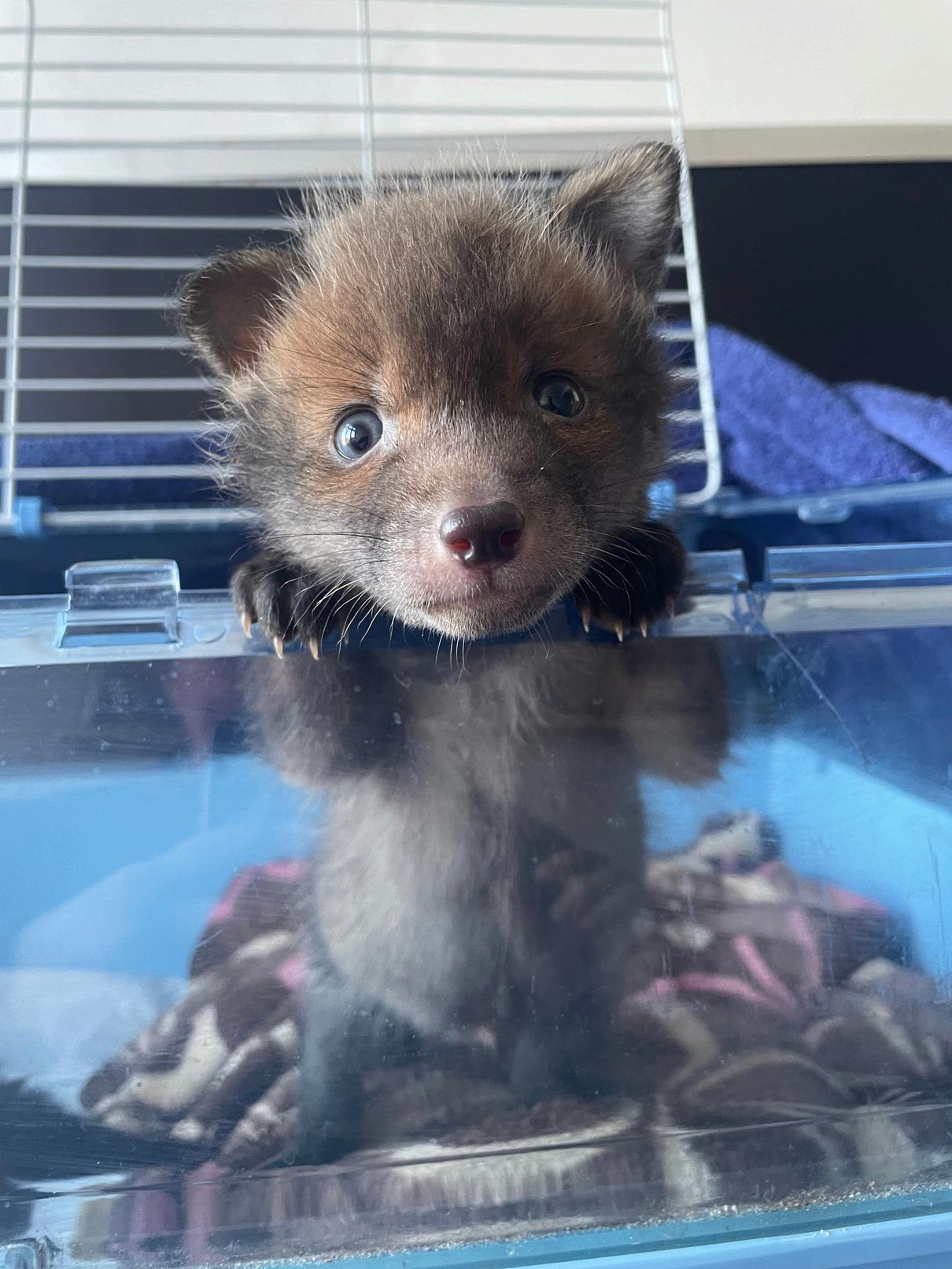
If you’re reading this, it is because
futureofourextraordinarywildlife
The summer is beginning to share its space with the first suggestions of autumn; our ‘Orphan Season’iscomingtoanendforanotheryear.2025hasseenuscaringforover2,000orphaned youngsters,withourfoxcubintake,alone,increasingby55%onlastyear.
Out in the wild, it is dispersal season, a time when the year’s new arrivals begin to ‘fly the nest’ (figurativelyandliterally!)tofindterritoriesoftheirown Pleaseconsiderthiswhenyou’reoutand about,especiallyontheroadsasthenightsdrawin–thisyear’syoungsterswillnotbeassavvy astheiroldercounterparts.Also,footballseasonisstarting,so,please,remembertorollupthose netsaftertraining/matches.

Withthechillyweatherapproaching,dofeelfreetovisitouronlineshop–we’veplentyoflovely fleecyWAFclothingtokeepyoucozyandwarm!

Wishingyoureallywell,
LouCowell ManagingDirector
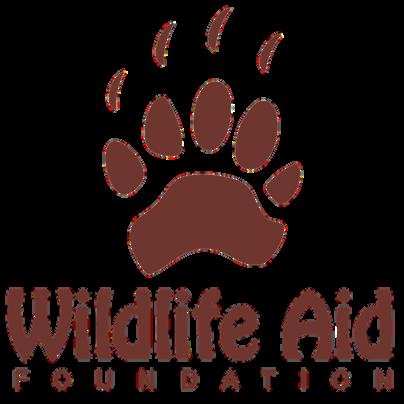
IcameacrosstheWildlifeAidFoundationafterIfound adisturbednestofbabypigeons Ididnotknowwhat to do with them or where to take them, I just knew I hadtosavethem.Ihavealwayshadaloveforwildlife andbeingoutinnature,feedingmygardenbirdsand a resident hedgehog I knew I wanted to do more to helpourBritishwildlifebutwasnotsurehow,so,when ItookthepigeonstoWAF,Ienquiredaboutbecoming avolunteer.
This led to me joining WAF in April 2020, within the husbandry team I have never looked back It has been the most rewarding job I have ever done! I look forwardtomyFridaymorningshift,everyweek;seeing the animals and the other volunteers is the highlight of my week. I can honestly say I have met the most amazing people, we all have the same shared love and passion for the animals in our care We all come together as a team and support each other, it feels likebeingpartofafamily,theWAFfamily.
byMarissaPatrick

I feel very grateful to be part of something so special and so rewarding. It’s a great feeling to helpandgivebacktonature Sincebeingavolunteer,Ihavegainedsomuchknowledge,andit continuestogroweachdayIamthere Ithasalsoopenedmyeyestothedamagethathuman impacthasonourwildlife,andhowimportanttheworkiswealldo.
Ourmainobjectiveistosaveandrehabilitateinjuredanimals,sotheycanbereleasedbackinto the wild, where they belong Not every story is a happy one, some days can be very emotional, butwhatmakesitworthwhileiswhenyougettoreleaseananimalbackintothewild Watching afoxcubtakeitsfirststepsoutofthesoftreleasepen,havingthatsecondchanceofbeingfree; feeding and nurturing tiny ducklings and watching them grow, to be released back into their lake; seeing a bird spread its wings and take flight! Those moments are magical, and it is the bestfeelingintheworldtoknowyouhavebeenpartofthatanimal’sjourney!

Being part of WAF has given me a sense of purposeandignitedapassioninmetocontinue helping our wildlife thrive for future generations toseeandengagewith.Aworldwithoutwildlifeis aworldwithoutpurpose
Interestedinvolunteering? ScantheQRcodetoseeallthe roleswehaveavailble

Little “Kirby” was found by the roadside, bleeding from the nose and infested with over 500 ticks No exaggeration-theywereeverywhere:betweenhis toes,inhisears,aroundhismouth,eyes,andeven on his genitals. These tiny parasites were draining thelifefromhim.
Despite being treated with a limited amount of Frontline (safe only in small doses for young animals), carers were still removing 30+ ticks, daily, for five days. While a few ticks might not usuallyharmafoxcub,thesheernumberleftKirby dangerously weak - too weak to even swallow milk.
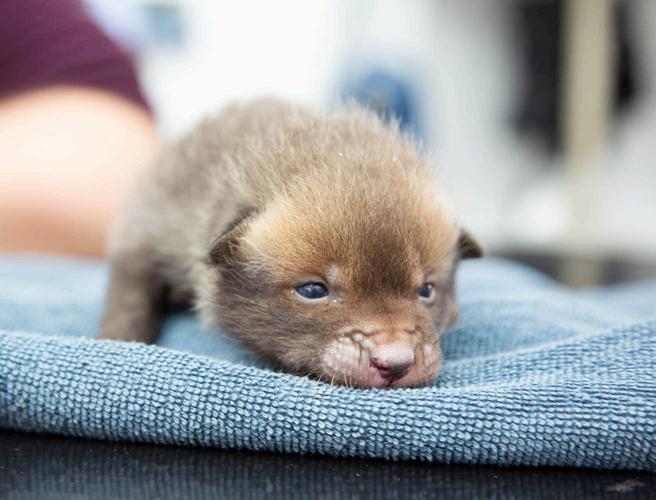
On his second day in care, his home-carer grew increasingly worried. But after 24 hours of warmth, subcutaneous fluids, and honey to keep his sugar up, Kirby finally latched onto the bottleat10:30p.m.-amomentsoexciting,hiscarerwokeherpartnertofilmit!
Fast-forward a few days, and Kirby was transformed Stronger, healthier, and needing a companion, he was soon joined by “Olbas,” named after the decongestant, due to her raspy breathing and suspected pneumonia. Severely underweight and struggling just to breathe, Olbaswasplacedinanincubatorforround-the-clockmonitoringandantibiotics.
Kirby’s carer stepped in again, hoping Olbas might become his playmate But, first, she needed tostabilise.For24hours,theywerekeptapartwhileOlbasreceivedsupportcare,includingthree dailynebulisertreatmentstoeaseherbreathing.
After 48 hours, the two were introduced, and the bond was instant Though Olbas wasn’t quite strong enough to play yet, Kirby became her devoted big brother, always checking she was warmandsafe,andeventoleratingherloud,congestedsnores.

Together,theybegantheirjourneyofhealing,withlove,care,andthecomfortofeachother.



When young Max first arrived, he was in a pitiful state. Initially rescued due to a leg injury, it quickly became apparent what his issue was severe mange! With large patches of his skin bare and sore, his left knee was also badly swollen with little mobility, making every step incrediblypainful.
InitialX-raysbroughtsomerelief–therewerenofractures–but they did reveal significant inflammation in the tissue around the joint, possibly a result of infection. Aloe vera gel was gently applied to soothe his irritated skin, while the veterinaryteambeganacarefultreatmentplan

It soon became clear that Max’s battle was not just skin-deep In his second week of care, he sufferedseizuresandhisconditiondeterioratedrapidly,showingsignsthathewasontheverge of going into septic shock. Quick intervention by our vet team, including fluids, antibiotics, and supportivemedication,kepthimstable.Itwastouch-and-goforawhile,butMaxwasn’tready to give up the fight. Day by day, he grew stronger. The swelling in his knee slowly subsided, his skin began to heal and his fur started to grow back His energy returned and, before long, he was pacing his enclosure, testing his legs and watching the world outside with bright, eager eyes.
After43daysinourcare,thevetgaveMaxtheall-clear.Hiskneehadregainedfullmovement, his coat had grown back thick and healthy, and the once-weak cub now stood tall, fit, and edhimbackintohishometerritory–justintimefordispersal ofindtheirownp




The start of this 'prickle' of hoglets’ story is heartbreaking Discovered in the road, where their mum lay lifeless, the four were lucky to have avoided the same fate. Thankfully, the siblings were spotted and quicklyremovedfromimmediatedanger
On assessment, they were all in good health, suggesting their mum was likely struckjustbeforetheywerefound.


werefirstinneedofsomeencouragementtoeat, r amount. So, in the capable hands of one of our etthemgoing,beforetheywereintroducedtotheir ntdownatreat!
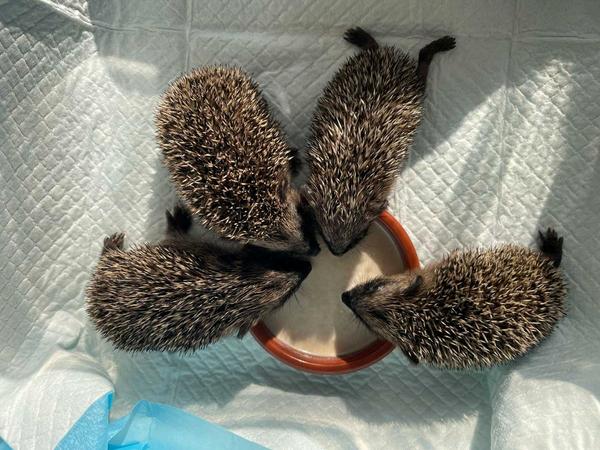
Now, the hoglets are safe in experienced hands. They will be fed, kept warm, and cared for around the clock until they are strong, round, and spiky enough to face the world on their own. Yet, there is a bittersweet truth, here: no matter how hard we work to protect them, we can’t shieldhedgehogsfromthedangersofourroads,forever
Fornow,though,thesefour haveasecondchanceand that,atleast,issomething theirbravelittlemumwould havewanted
ScantheQRcodetoseethis adorablequartettucking themselvesinforbed.


Just your daily reminder to check your garden beforedoinganyworktoit!
Thesearejusthalfoftheinjuriesthatthishedgehog sustained when she was accidentally struck by a strimmer.
Withfurtherinjuriestotherightsideofherfaceand anothertooneofherpaws,shewasveryluckythat several of them were able to be cleaned and sutured,byvetJudith.
But having to remain with us for a while, to let the woundsrecover,meantshewasmissingoutonher breeding season. And, as we all know, hedgehogs need all the opportunities they can get to have somehoglets!
With sutured wounds helping to speed up the healingprocess,shewasabletobereturnedtoher territorylessthantwoweekslater.
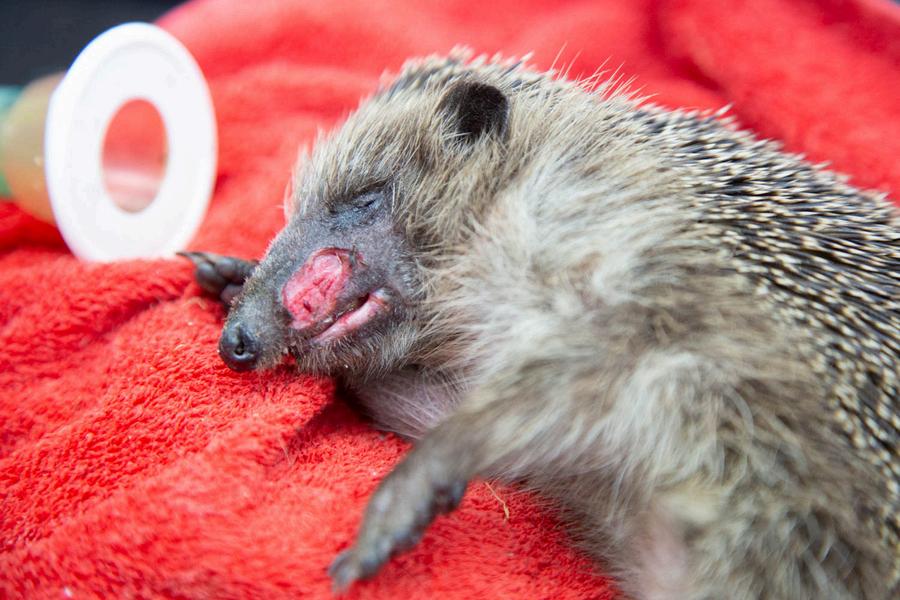
Themomentamemberofthepublicusesthewords"he'slikeaballoon"whentalkingabouta hedgehog,weimmediatelyaskthemtobringtheanimalin.
Andasyoucanseefromthephoto,youcanunderstandwhy,thispooradulthogwassuffering fromBalloonSyndrome

Balloon syndrome is a condition commonly caused by an underlying injury or infection. Having removed over 100ml of air, the vet team continued to investigate the cause of his condition, where he was discovered to have multiple injuries, including a fracturetohisupperjaw,andacollapsedlung.
The trauma he had sustained was, sadly, catastrophic, leaving our vet team with the only optionbuttoendhisexcruciatingpain

Whenhedgehogsare outtoforageinthe evening,theycan travelforupto2miles, that’salongwayfor
Oneofthesebadgercubswas,sadly,notliketheotherwhenthepairofthemarrived
Meet“Farley&Rusk”,akabadgercubsnumberOneandTwoof2025.Discovered,luckily,bythe parentsofoneofourformervets,thesisterswerespottedoutsideoftheirsettand,whilstFarley appeared bright, alert and had lots of attitude, the same couldn’t be said for Rusk, who was muchweaker,coveredinfleas,andhadaworryinglylowtemperature
Stillacoupleofweeksawayfrombeingofanagetoleavethesett,wehadnoideahowthepair endedupintheirsituation.Butwithbothcarryingaheavyfleaburden(mumwouldusuallytake careofthis),wesuspectedthey’dbeenaloneforawhileandoptedtoventureoutofthesettto tryandfindmum
Alex and Lee, two of our trusted rescuers, collected the cubs and scanned the area for any obvious sett and/or parents, but with Rusk struggling, they rightly got the siblings back to the hospital,whereourvet,Judith,andrehabmanager,Sarah,begantheslowprocessofwarming theduoupandprovidingthemwithtreatmentforthefleas,aswellasvitalfluids
It breaks our hearts to think how scared the sisters must have been, and what may have happened to their mum. But we are focused on continuing their recovery and giving them the bestcarepossible(Simonwouldcertainlyhavehadsomethingtosayifwedidn’t!).Thesisters formed the foundation to our now ten-strong badger clan, and will soon, along with three of theiradoptedsiblings,beheadingouttotheirsoft-releasesite


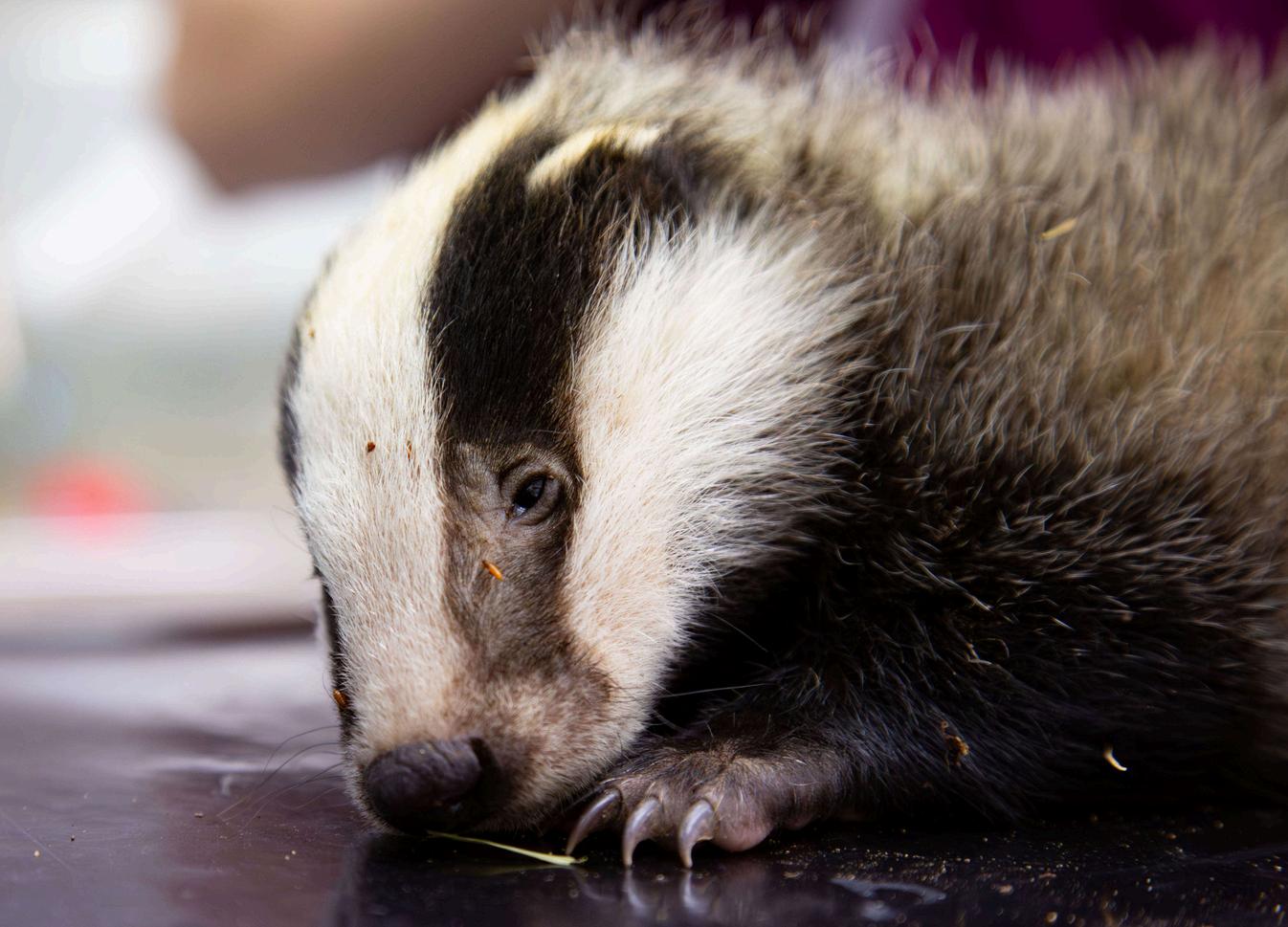
When our rescue team got the call about a small, wobbly animal at the side of a quiet country road, we hadnoideajusthowspecialthefindwouldbe.Nestled inthegrasswasabadgercubunlikeanywe’dseenin years creamy white fur, pink nose, and unmistakable ruby-redeyes.Meet“Albie,”ararealbinobadger.
From the moment Albie arrived, we knew he would needalittleextracare.We’remonitoringhimcloselyto makesurehestaysstrongandhealthy.Thankfully,this littlecubhasalreadyshownushe’sfullofspirit,eating well, growing in confidence, and enthusiastically “redecorating” his pen by pulling apart straw, tossing his enrichment toys around, and generally creating a messthatonlyabadgercouldlove.
Hisjourneymaybealittledifferentfromthatofmostbadgercubs,butwithyoursupport,wecan ensurehehaseverychancetogrowintothestrong,wildanimalhewasborntobe

AfewweeksafterAlbiearrivedandhewasfullystable,hewasintroducedtoafewofoursmaller cubs,sohecouldgentlybeintegratedintobadgerclanlife.Onceweweresurehehadfoundhis place with them, the group of four was moved in with the big guys, where you can now watch them in their final stages of rehabilitation In just a few weeks, half of the group will head out to theirsoft-releasesite.



Weighinginat around8-12kg, badgersarethe UK’sbiggestliving landpredator.

Thisyear,wehaveseenover50patientsarriveincareasadirectresultofbecomingentangled. String,wireandnettingarethemostcommonculprits,butforthistawnyowl,itwasfishingline, and,sadly,itisfarfromthefirsttimeit’shappened
Theowlinnocentlyflewupintoatreetoperchbut,insteadofperching,foundhimselfwithfishing linewrappedaroundhisleftwing,leavinghimdanglingoveralake.OurfriendsattheRSPCAgot the call, and ARO Sam came to the rescue, with some extra help from the environment agency andtheirboat

Usinganetandalong-reachcutter,Samheldthenetunderneaththeowl;whilstthefishingline wascutabovetheowl,Samwasabletocatchtheowlinthenetandbringhimtosafety.Aswe wereunsurehowlonghe’dbeenentangledandhavingseentheimagesofhowhewastrapped, we were expecting the worst, but on initial assessment he had somehow come away with just minor feather damage. We know all too well, however, that ligature wounds can take up to 10days to show themselves. So, sadly for him, he had to remain with us until we were sure no woundsbrokeout.
After 12 days in care, and some initial shoulder swelling that needed to resolve, this very lucky tawnymadeafullrecovery,andwasabletobereleasedbacktohishomerange.



Theeyesofanowl arenottrue “eyeballs.”Their tube-shapedeyes arecompletely immobile,providing binocularvision.
Our brood of little owls has provided us with the b posesforthecamera,thisyear.
The very first arrival of the year, affectionat nicknamed “Jekyll,” had quite the dramatic entran He was discovered by an inquisitive spaniel, along countryside footpath. With no sign of a nest near despite a careful scan of the area, it soon becam clear that Jekyll was on his own That twist of fa madehimourveryfirstowlorphanoftheseason.
Over the following weeks, three more little owls join and nest site. Their reasons for coming into care predatorattack,whileothershadsimplyfoundthem
Each was thoroughly assessed and, once given th withoneofourhomecarers,beingcloselymonitoredtoensuretheywerefeedingwell,steadily gainingweight,anddevelopingthestrengththey’dneedtothrive.

Oncetheyhadpassedthestageofneedingregularsupport,theirjourneybacktothewildcould really start All four owls were transferred to our soft-release site, where a 100-metre aviary awaited them This spacious enclosure, complete with natural foliage, perching spots, and plentyofroomtostretchtheirwings,providestheperfectsteppingstonebetweenhand-rearing andfullindependence.Here,theyoungowlscansafelypracticeflying,strengthentheirmuscles, and,mostimportantly,begintolearntheessentialskillsofhuntingforthemselves.
Young owls begin to disperse in late summer to early autumn, so it won’t be long, now, until theseagilelittlebirdswillfinallyflyfree
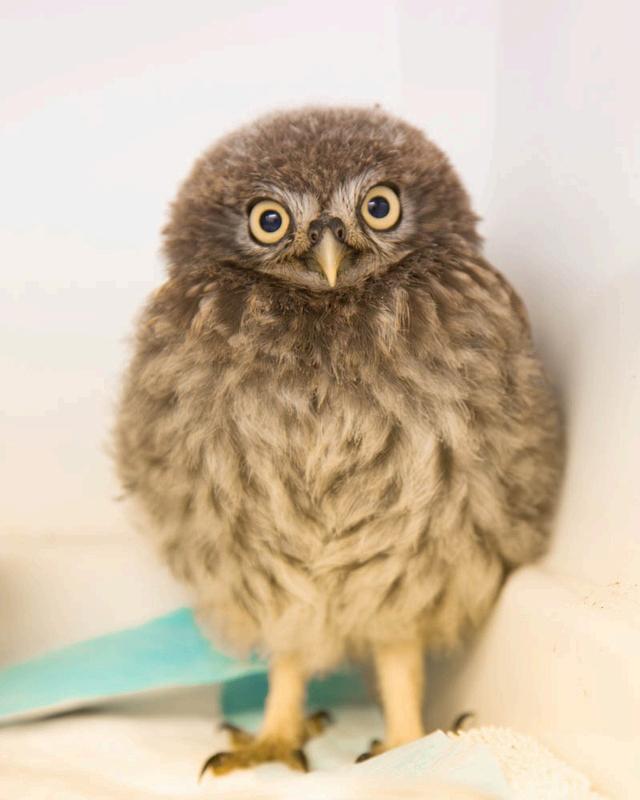

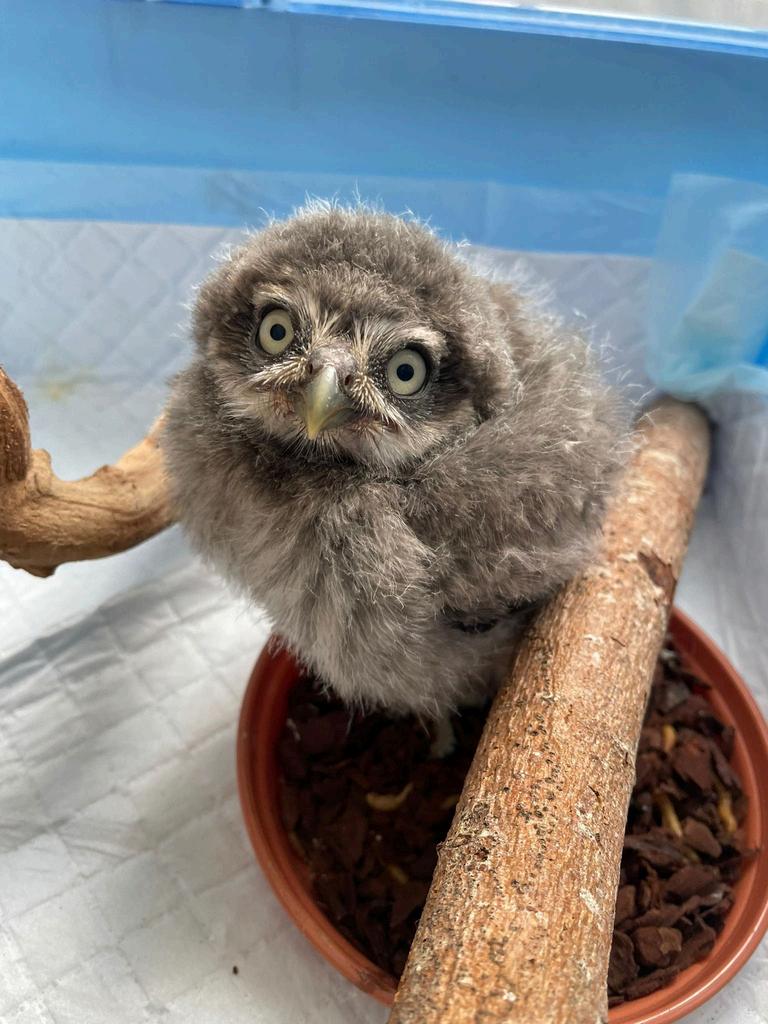

Sometimes,naturejusthasotherplans.
Deerarenowhavingyoung,andthistinyday-old roe fawn was our second of the season. Sadly, the first was attacked by a dog, and had passed away on arrival. But “Hershey’s” story was out of everyone’scontrol.
Our reception team received a call about an adult roe that appeared to be in distress whilst giving birth. Volunteer vet, Matt, and vet nurse, Carina, headed out to assess the situation. Once onthescene,itwasevidentthemotherhadbeen struggling for a long period of time to birth her secondfawn,which,heartbreakingly,hadalready passed away. The risk of infection and level of flystrike to the adult resulted in the difficult decision to humanely euthanise her, to prevent anyfurthersuffering
But, nestled in the undergrowth, was her first-born fawn, weak and cold, the fawn had already gone24hourswithoutmilkandwarmthfromhermum Thevetteamheadedbacktothecentre, withHersheyintow.

Over the following 48 hours, she received intensive care, whilst keeping warm, snuggled in blankets,underaheatlamp IVfluidswereadministeredwithadditionalvitaminsandelectrolytes tohelpherbodyrecover WewereoverthemoonwhenCarinamanagedtobottle-feedhersome milkreplacementand,astheysay,therestishistory.
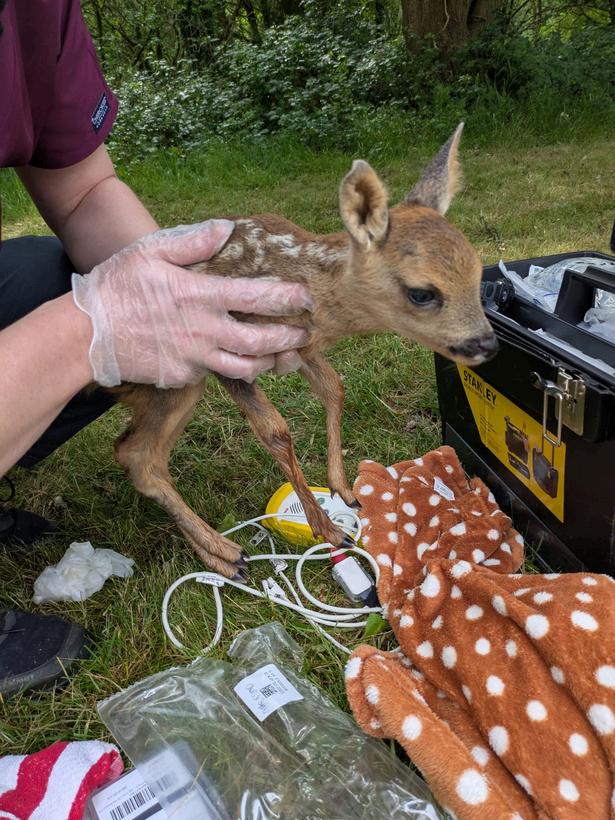
Fully stabilised, Hershey was able to be transferred to specialist deer carers, where we hope she recoversfromherdifficultstartand,oneday,isfreetoroam,backinthewild
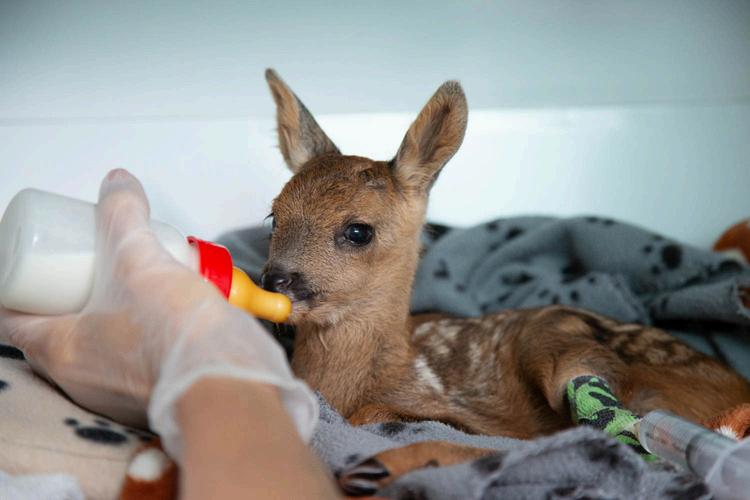


In a single day, we surpassed last year’s entire intake of brown hares, but, despite their undeniablyadorableness,thethreeleverets(that’sthenameforbabyhares),sadly,didn’tneed tobeadmittedatall.
Ataroundaweekold,theyhadbeenpickedupatacarbootsaleandhandedtotheorganiser Unfortunately, because no one knew exactly where they had come from, we were unable to return them to any possible nesting site where, we’re sure, their mother spent days frantically searchingforthem.
Hares give birth above ground; the mother then leaves her young and returns only once every 24 hours to feed themfor only a few minutes While this may seemrisky, it’s actually a survival strategy:herabsencehelpsavoidattractingpredatorstothenest,andtheleverets’coatskeep themincrediblywellcamouflaged.
We completely understand why someone might think they needed rescuing, but, sadly, this well-meaning action meant they had to grow up in care With nothing (thankfully) wrong with the leverets, they were given rehydration fluids by the vet team, before being transferred to a home-carerforone-on-onecare.
Needingsuchaspecificdiet,leveretscanbeverydifficulttohand-rear,withgut-stasisbeinga hugeissueforbothrabbitsandhares,and,sadly,asaresult,twooftheleveretsdidn’tmakeit However,after59daysincare,thesurvivingleveret,lookingmuchmorelikeanadult,wasable tobereleased,backtothewild.


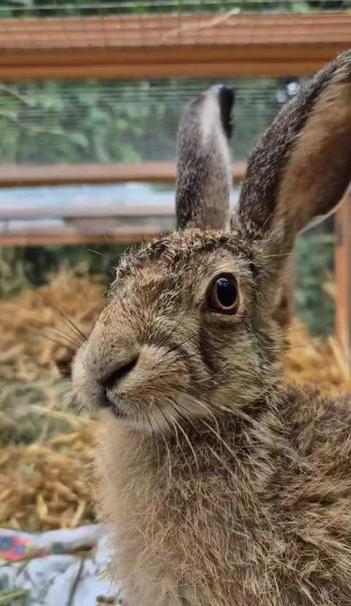
WeinterruptyourregularscheduledprogrammingtobringyouthisadorablephotoofBuzzand Lightyear! Due to GDPR, we can't explain exactly why they're called this, but it doesn't matter, because,seriously,haveyoueverseensuchadorable-lookingpigeons?!
The siblings are with us as a result of falling from their nest, earlier this month, and their yellow fluff tells you all you need to know about their age - they're not quite ready for fledging, yet Sadly, falling from nests is one of the most common reasons of admission for pigeons, due to their,well,frankly,terriblenest-buildingskills-lookinglikejust5twigslayedacrosseachother, it’snosurprisethatevenalight-windcanresultinacollapse.
Whilst,ideally,thepairwouldbeinthesafetyoftheirnestsite,learningalltheyneedforsurvival fromtheirparents,andenjoyingawildandfreelife,they,instead,willbewithusforafewmore weeks, yet Over those weeks, they’ll continue to practice their flapping, balancing, and short hops-tinypigeonworkoutsthatwill,oneday,turnintostrong,confidentflights.
With a little more time and a lot more growing, Buzz and Lightyear will be ready to take to the skies and join their feathered friends Having each other as company will certainly help them learn good feral pigeon-etiquette and, thus, integrate more smoothly, upon release, into an alreadyestablishedflock.

Believeitornot,it’snotactuallyveryoften that orphaned patients are, in fact, orphaned Sometimes it’s the case that the parents just haven’t returned, nests have been destroyed, the adults have been disturbed, resulting in them abandoning their offspring, or we’re not given the full location of where the orphans have come from, which means wecan’treturnthem.
Sadly, none of the reasons listed above aretrueforthesetinyferals!

Instead, the nestlings became orphaned because of their parent being, sadly, attacked by a sparrowhawk. A member of the public witnessed the whole ordeal and scooped up the two siblings,bringingthemtousforsafety.Obviously,predationisapartofnatureand,whilstweare saddenedthattheseyoungsterswon’tgettolearnvitalskillsfromtheirparent,we’regladtosee themstillgetachancetoliveawildandfreelife,inthefuture
We’re not sure sliding down a conservatory roof is a usual part of the fledging process, which would explain why this collared dove, then, didn’t seem to go anywhere. Early fledging is one of the common reasons we see a whole host of bird species, here at WAF. But, that’s not the only issuethatfacesearlyfledgingcollareddoves.

As the species isn’t actually native to the UK, but, instead, originate from the sunnier climes of India and West Asia, the reduction of sunlight here in the UK, can often result in the low production of calcium and, in turn, cause collared doves to develop soft beaks and bones, which can then leadtodeformitiesandfragilityintheirskeleton.
Thankfully for this guy, though, he’s showing no signs of the condition and is well on his way to beingalittlemorereadyforflight!

We don’t think we need to tell you who came out ontop,although,sayingthat,wedon’tknowwhat thecatlookslike!
But, sadly, this adult pipstrelle has sustained a puncturewoundtohisleftwing.Ourvetteamwas abletocleantheinjuryandapplysurgicalglueto the tear, which will help it heal, quicker He’s now inneedofafewdaysantibiotics,sohe’llremainin carewhilstherecievesacourseofmedication,as well as some time to allow the wounds to heal.
Luckily for him, he’s a bat, and they heal super quickly!

Wing fractures are one of the most frequent injuries we see in bats, which is understandable with such tiny fragile bones. This one, sadly, had sustained a break to his left radius, due to a predator attack, and required surgical intervention - no easy taskwiththeirminisculeskeleton
Thankfully, our vets have become dab hands at bat orthopaedics, and were able to successfully secure a surgical pin in place, which allowed the fractured bones to heal in a straightline
Under the expert care of Steve from Surrey Bat Rescue, the pipistrelle needed weekly check-ups to ensure there were no complications and the pin was doing its job, all whilst also ensuringthebatwascopingwell

After just a few short weeks, Steve was able to begin the pipistrelle’s rehabiliation, helping him to rebuild his flight strength,beforereleasinghimbacktohishomerange.


AtWildlifeAid,weworkwithnearly200Britishwildlifespecies,andyoursupportplaysan importantpartinrescuingandrehabilitatingthemall.Let'sdiveintothewildworldofsomeother quirkycritterswegettohelp

Justlookatthatlittleface!Okay,it'snotthecutest,but anythingwiththename‘slowworm’probablyisn't goingtohavecutenessinitsfavour.
Asyoucansee,he'slosttheendofhistail-heactually cameinwiththetailstillpartiallyattached Havingbeen pickedupbyacat,wewereabletocleantheopening andofferhimasafespacetorestwhilstherecovered. But,thecoolestpart...histailwilleventuallygrowback!
ThisisaNortherngoshawk!Lookingverysimilartoa sparrowhawk,butweighingALOTmore,thisusuallyelusive, deepforest-dwellingbirdwasfoundcollapsedinthemiddle ofGuildford,withavisibleheadinjuryandmoreinjuriestoher keelandback.
After3-weeksincare,shefinallybeganflyingagain,butin orderforhertofullyregainherflightstrength,shewas transferredtoanotherwildlifehospitalthathadamuch largerflightaviaryavailableforher.

Thisyoungmouseandhistwosiblings-whohadarrivedthe daybefore-werefoundinagarden.That'sit,that’stheir story.Genuinely.Thethreewerebroughttous,which,in itself,isunderstandablebecauseallthreestillhadtheireyes closed.Butobservinganyorphanedanimalforaperiodof timeissoimportant,toensuretheyare,indeed,orphaned. Thetrioiscurrentlyinthecapablehandsofourcareteam, whowillberesponsibleforfeedingthem,everycoupleof hours;wishthemluck
Foundinacarpark,thislonelytuftedducklingisalittle latetotheparty Withthemajorityofourducklingsnow livingtheirbestlives,outinthewildsofSurrey,"Tufty"will needtobegiventheall-clearbeforewecanmixhimwith anyofthesmallnumberofmallardswestillhave.
Usuallyfoundinfreshwaterlakesandponds,wherethey feedonaquaticinvertebrates,plants,andmolluscs,Tufty wascertainlyfarfromthesetypesofhabitats!




